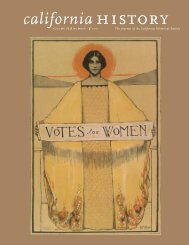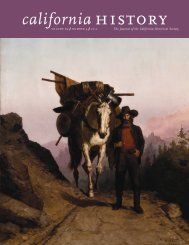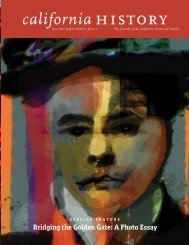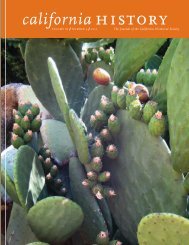Volume 90, Number 1 - California Historical Society
Volume 90, Number 1 - California Historical Society
Volume 90, Number 1 - California Historical Society
Create successful ePaper yourself
Turn your PDF publications into a flip-book with our unique Google optimized e-Paper software.
the multicolored glass set in the two peaked windows<br />
adjoining the front door. Similarly, fellow<br />
Bohemian and sculptor Arthur Putnam could<br />
well have carved the rising sun, described as “an<br />
Aztec nimbus,” that sat above the door, while<br />
Putnam or another craftsman from the gregarious<br />
coterie contributed the scarlet cross that<br />
arose from the gable and the silver Moslem crescent<br />
on the door. 8<br />
The Bohemian Club provided Miller with a base<br />
in the city for drinking and socializing and, until<br />
the 1<strong>90</strong>6 earthquake and fire demolished its<br />
building and the majority of its contents, a place<br />
to archive some of his papers. He participated in<br />
the “jinkses” that related to his own experience,<br />
such as the 1<strong>90</strong>3 theatrical and musical evening<br />
honoring a companion of his London days, fellow<br />
miner and longtime rival Bret Harte. Five<br />
years later, he joined in a comparable celebration,<br />
the “Days of ’49,” with fellow performers<br />
“Sunset Norris” (Frank Norris of Octopus fame),<br />
“Sundown Field” (Charles K. Field, editor of<br />
Sunset magazine and Bohemian Club president<br />
from 1913 to 1914), and Arthur (repackaged as<br />
“Coyote”) Putnam. 9<br />
So much did the Poet of the Sierras enjoy his<br />
Bohemian experience that not long after its<br />
launch in 1<strong>90</strong>4, he joined the Sequoia Club,<br />
society figure Ednah Robinson’s revival of a<br />
short-lived earlier group, a female response to<br />
the Bohemian Club. 10 Uniquely for its time, the<br />
reorganized Sequoia Club integrated genders.<br />
Headed by Charles S. Aiken, editor of Sunset (and<br />
shortly to be Robinson’s husband), the Sequoia<br />
Club signaled its revival with a dinner at the<br />
St. Francis Hotel honoring the author Gertrude<br />
Atherton. Other receptions followed, along with<br />
concerts and art exhibits. Harr Wagner, who<br />
became Miller’s close associate and first biographer<br />
(and the Sequoia Club’s third president),<br />
commented that the poet was inspired to host a<br />
barbecue at his ranch for a hundred of his fellow<br />
Sequoians. 11<br />
44 <strong>California</strong> History • volume <strong>90</strong> number 1 2012<br />
Given the logistics of transport, entertaining one<br />
hundred guests at home would have been marginally<br />
more demanding than attending the San<br />
Francisco gatherings. The Bohemian schedule<br />
of performances at 9 p.m., with dinner following<br />
at 11, would have been a challenge for any<br />
member who wished to be home the same night,<br />
especially if that home happened to be in the<br />
hills behind the decorous suburb of Fruitvale and<br />
ten miles from the center of Oakland. With the<br />
last San Francisco–Oakland ferry leaving around<br />
midnight and connecting streetcars on the other<br />
side running only every hour, Miller could not<br />
have lingered long over dinner. In a few lines of<br />
a surviving note, he reassured a concerned friend<br />
that he did his “stint at the Bret Harte jinks, then<br />
caught the boat and walked up the hill to the<br />
Hights and slept in my own bear skins, as I told<br />
you I would.” 12<br />
As with almost everything connected with Miller,<br />
the facts, as related by both him and observers,<br />
are contradictory. However, almost all accounts<br />
concur in describing the hike up the “tawny hill”<br />
as a strenuous one. Commencing at the little<br />
settlement of Dimond at the intersection of Hopkins<br />
(now MacArthur) and Fruitvale Avenues,<br />
the purported length of the trip varied markedly<br />
depending on the age and fitness of the traveler.<br />
What was two miles for a couple of college students<br />
in 1892 was five for the author, publisher,<br />
and arts-and-crafts manufacturer Elbert Hubbard<br />
a decade later. At least by the time the two Baptist<br />
students attempted the trip, the electric Highland<br />
Park and Fruitvale line had replaced the horsedrawn<br />
Brooklyn and Fruit Vale (as the name of<br />
the suburb was originally spelled) streetcar and<br />
now extended from Fruitvale center to Dimond.<br />
But even under ideal circumstances—a private<br />
carriage driven all the way from City Hall at<br />
14th and Broadway—the trip to the Hights was<br />
a two-hour trek. 13 Usually Miller made good use<br />
of a horse and buckboard when commuting up<br />
and down his hill. Returning from San Francisco<br />
after the Bret Harte musicale, he made the best









